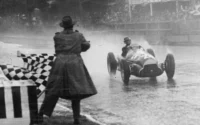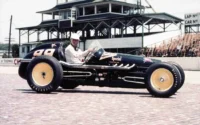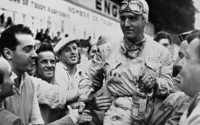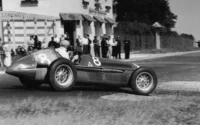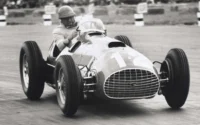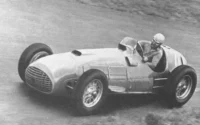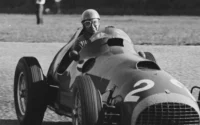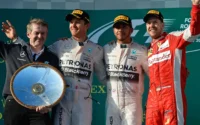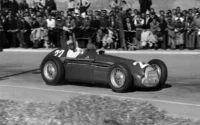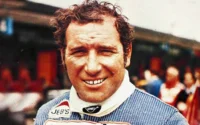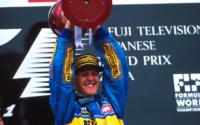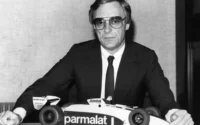The 1951 F1 season was the second running of the FIA World Championship of Drivers, starting on 27 May and concluding on 28 October 1951.
This season, drivers and their teams ran eight races, compared to seven in the 1950 season, each contributing points to the Drivers’ Championship.
Season
Beyond the championship races, the 1951 season was further enriched by an additional 14 races that welcomed Formula 1 spec cars. Although these races provided a platform for teams to test race strategies and their cars, they did not contribute to the championship standings. Significant in their own right, they were considered separate from the main championship to offer fans more action and Formula One drivers more opportunities to race throughout the season.
The 1951 Formula One season saw the rise of Ferrari and their advanced, naturally aspirated 4.5-litre cars, which emerged as formidable challengers to the dominant Alfa Romeos. The Alfa cars, while impressive, were beginning to reach their peak in their developmental curve, making it difficult to eke out further improvements.
Ferrari’s cars proved to be especially good at exploiting the main weakness of the Alfas—their fuel-guzzling engines. This advantage for Ferrari was showcased during the Silverstone race weekend, where the Alfa engines’ inefficiency was glaringly obvious. Even though Alfa Romeo clinched four victories, with the legendary Juan Manuel Fangio ultimately securing the championship title, Ferrari’s three impressive race wins saw a shift in team dominance. Those victories were seen as the beginning of the end for the once-dominant Alfa cars.
The season also witnessed the unique appearance of BRM with their V16 engine at Silverstone, a machine that added variety to the grid. On the other end of the spectrum, the older Talbot cars, lacking in speed and modern features, were progressively outpaced and overshadowed by their competitors.
1951 F1 Entries drivers and teams
| Team | Driver | Race entries | Wins | Podiums | Poles | Fastest Laps |
|---|---|---|---|---|---|---|
| Alfa Romeo | Consalvo Sanesi | 4 | ||||
| Emmanuel de Graffenried | 5 | |||||
| Felice Bonetto | 4 | 1 | ||||
| Giuseppe Farina | 8 | 1 | 4 | 2 | ||
| Juan Manuel Fangio | 8 | 3 | 5 | 5 | 5 | |
| Luigi Fagioli | 2 | 1 | 1 | |||
| Paul Pietsch | 1 | |||||
| Alta | Joe Kelly | 1 | ||||
| BRM | Ken Richardson | 1 | ||||
| Peter Walker | 1 | |||||
| Bromme | Rodger Ward | 1 | ||||
| Deidt | Duane Carter | 1 | ||||
| Mack Hellings | 1 | |||||
| Mauri Rose | 1 | |||||
| Tony Bettenhausen Sr. | 1 | |||||
| ERA | Bob Gerard | 1 | ||||
| Brian Shawe-Taylor | 1 | |||||
| Ferrari | Alberto Ascari | 7 | 2 | 4 | 2 | |
| Francisco Landi | 1 | |||||
| Luigi Villoresi | 7 | 3 | ||||
| Peter Whitehead | 4 | |||||
| Piero Taruffi | 5 | 1 | ||||
| Rudi Fischer | 2 | |||||
| Gordini | Aldo Gordini | 1 | ||||
| Andre Simon | 4 | |||||
| Maurice Trintignant | 4 | |||||
| Robert Manzon | 4 | |||||
| Hall | Bill Mackey | 1 | ||||
| HWM | George Abecassis | 1 | ||||
| Stirling Moss | 1 | |||||
| Kurtis | Bill Schindler | 1 | ||||
| Carl Forberg | 1 | |||||
| Carl Scarborough | 1 | |||||
| Cecil Green | 1 | |||||
| Chet Miller | 1 | |||||
| Cliff Griffith | 1 | |||||
| Duke Nalon | 1 | 1 | ||||
| Freddie Agabashian | 1 | |||||
| Gene Force | 1 | |||||
| Jack McGrath | 1 | 1 | ||||
| Johnnie Parsons | 1 | |||||
| Lee Wallard | 1 | 1 | 1 | 1 | ||
| Manny Ayulo | 1 | 1 | ||||
| Mike Nazaruk | 1 | 1 | ||||
| Sam Hanks | 1 | |||||
| Troy Ruttman | 1 | |||||
| Walt Brown | 1 | |||||
| Kuzma | Walt Faulkner | 1 | ||||
| Lago | Andre Pilette | 1 | ||||
| Duncan Hamilton | 2 | |||||
| Eugene Chaboud | 1 | |||||
| George Grignard | 1 | |||||
| Guy Mairesse | 2 | |||||
| Henri Louveau | 1 | |||||
| Jacques Swaters | 2 | |||||
| Johnny Claes | 7 | |||||
| Jose Froilan Gonzalez | 6 | 1 | 5 | 1 | ||
| Louis Rosier | 7 | |||||
| Philippe Etancelin | 5 | |||||
| Pierre Levegh | 3 | |||||
| Yves Giraud-Cabantous | 6 | |||||
| Lesovsky | George Connor | 1 | ||||
| Marchese | Chuck Stevenson | 1 | ||||
| Maserati | Antonio Branca | 1 | ||||
| Birabongse Bhanudej | 1 | |||||
| David Murray | 2 | |||||
| Harry Schell | 2 | |||||
| John James | 1 | |||||
| Johnny McDowell | 1 | |||||
| Juan Jover | 1 | |||||
| Louis Chiron | 7 | |||||
| Philip Fotheringham-Parker | 1 | |||||
| Moore | Henry Banks | 1 | ||||
| OSCA | Franco Rol | 1 | ||||
| Pawl | Jimmy Davies | 1 | ||||
| Schroeder | Bobby Ball | 1 | ||||
| Duke Dinsmore | 1 | |||||
| Scuderia Milano | Francisco Godia | 1 | ||||
| Onofre Marimon | 1 | |||||
| Sherman | Andy Linden | 1 | ||||
| Trevis | Bill Vukovich | 1 | ||||
| Vandervell | Reg Parnell | 3 | ||||
| Veritas | Peter Hirt | 1 | ||||
| Watson | Joe James | 1 |
1951 Formula 1 Race Calendar
| Date | Grand Prix | Laps | Lap Distance | Country |
|---|---|---|---|---|
| 27 May | Bremgarten | 42 | 7.28 | Switzerland |
| 30 May | Indianapolis | 200 | 4.01 | Indianapolis |
| 17 Jun | Spa-Francorchamps | 36 | 14.08 | Belgium |
| 01 Jul | Rheims | 77 | 7.82 | France |
| 14 Jul | Silverstone | 90 | 4.7 | Great Britain |
| 29 Jul | Nurburgring | 20 | 22.77 | Germany |
| 16 Sep | Monza | 80 | 6.276 | Italy |
| 28 Oct | Pedralbes | 70 | 6.308 | Spain |
1951 Formula 1 Race Reports
Round 1: Swiss Grand Prix
Race date: 27 May 1951
Circuit: Bremgarten, Bern, Switzerland
Laps: 42
Circuit length: 7.28 km (4.524 miles)
Juan Manuel Fangio delivered a brilliant drive in appallingly wet conditions to win the 1951 Swiss Grand Prix, cementing his reputation. Autosport wrote, “His fearless passage through the circuit’s innumerable fast bends gained him the sincere admiration of all, elevating him still higher in the ranks of Grand Prix drivers.” Fangio had been haunted by running over a black cat during a reconnaissance drive the night before the race. “I had resisted the temptation to let myself be dragged down by superstition,” he said. Italian driver Piero Taruffi, who drove for Ferrari, finished second and fellow Italian driver, Nino Farina rounded out the podium in third, in the second Alfa Romeo car.
Full Race Report
Round 2: Indianapolis 500
Race date: 30 May 1951
Circuit: Indianapolis Motor Speedway
Laps: 200
Circuit length: 4.023 km (2.500 miles)
The 1951 Indianapolis 500 was the second round of the eight-race World Championship season. However, as it took place just three days after the Swiss Grand Prix, it failed to attract any regular Grand Prix competitors, participation was logistically impractical.
Lee Wallard emerged as the race winner, earning 9 points towards the World Championship—8 for victory and 1 for setting the fastest lap. Despite not competing in any other World Championship rounds that season, he finished seventh in the final standings.
Mike Nazaruk secured second place, while third was shared between Jack McGrath, who led the first 100 laps, and Manny Ayulo, who took over for the second half of the race.
Full Race Report
Round 3: Belgian Grand Prix
Race date: 17 June 1951
Circuit: Circuit de Spa-Francorchamps
Laps: 36
Circuit length: 4.023 km (2.500 miles)
Nino Farina claimed victory at the 1951 Belgian Grand Prix driving a supercharged Alfa Romeo. Despite only 13 cars starting the race, across three different manufacturers, the event drew a record crowd. There were three additional entries, including two Maseratis, that failed to make it to the event. Juan Manuel Fangio debuted a new suspension system equipped with specially designed concave wheels to accommodate the brake drums. The race would mark the only occasion in Fangio’s illustrious Formula 1 career, excluding retirements, where he finished outside the top four. Nevertheless, he earned a point for recording the fastest lap of the race. Although he placed ninth and only the top five finishers scored points, this result allowed him to maintain his record of scoring in every race he completed. The Ferraris of Alberto Ascari and Luigi Villoresi finished second and third, respectively.
Full Race Report
Round 4: French Grand Prix
Race date: 1 July 1951
Circuit: Reims-Gueux
Laps: 77
Circuit length: 7.816 km (4.856 miles)
Juan Manuel Fangio and Luigi Fagioli, driving an Alfa Romeo, claimed victory at the 1951 French Grand Prix, finishing ahead of Ferrari drivers Jose Froilan Gonzalez and Alberto Ascari in second. Luigi Villoresi finished in third place for Ferrari. It was the first of three occasions where two drivers would be credited with a Grand Prix win after sharing a car.
Luigi Fagioli’s victory in this race marked his first and only World Championship win, making him the oldest driver ever to win a Formula One Grand Prix—a record that still stands.
Additionally, this race is the longest Formula One Grand Prix in F1 History in terms of total distance covered. The 77 laps around the 4.856-mile Reims-Gueux circuit added up to a gruelling 373.961 miles.
Full Race Report
Round 5: British Grand Prix
Race date: 14 July 1951
Circuit: Silverstone Circuit
Laps: 90
Circuit length: 4.649 km (2.888 miles)
The 1951 British Grand Prix at Silverstone was expected to showcase the much-anticipated BRM cars, the Type 15, powered by a 1½-litre 16-cylinder supercharged engine, and the first car to use disc brakes in road racing, they finished fifth and seventh. “The cars showed up exceedingly well,” noted the Guardian, despite drivers requiring first aid for burns due to excessive heat. The writer also pointed out that “The engine needs to be permitted to develop full power without the risk of blowing up.” The race was won by Jose Froilan Gonzalez in a Ferrari, marking the first time an Alfa Romeo did not win a championship event. An Alfa Romeo was still in second place though, in the form of the year’s eventual champion Juan Manuel Fangio. Luigi Villoresi became the second Ferrari on the podium after he finished in third place, two laps behind.
Full Race Report
Round 6: German Grand Prix
Race date: 29 July 1951
Circuit: Nürburgring
Laps: 20
Circuit length: 22.810 km (14.173 miles)
The Nürburgring hosted a world championship race for the first time with the 1951 German Grand Prix. Alberto Ascari secured his first world championship win for Ferrari.
Ascari’s victory propelled him to second place in the 1951 Championship standings, ten points behind Juan Manuel Fangio who finished in second and extended his lead from the previous race. Following his second consecutive podium finish in third place, Jose Froilan Gonzalez moved up to third in the standings, tying on points with Farina and Luigi Villoresi.
Full Race Report
Round 7: Italian Grand Prix
Race date: 16 September 1951
Circuit: Autodromo Nazionale di Monza
Laps: 80
Circuit length: 6.300 km (3.915 miles)
Ferrari driver Alberto Ascari won the 1951 Italian Grand Prix, beating championship contender and Alfa Romeo driver Juan Manuel Fangio, who retired on lap 39 due to engine issues. This victory cut Fangio’s lead in the 1951 Drivers’ Championship to two points. Ascari faced a setback when his car caught fire during a pit stop, but the fire was quickly extinguished, allowing him to continue. Fangio eventually secured the first of his five world titles at the season finale in Spain. Ascari’s teammate Jose Froilan Gonzalez finished second, while Alfa Romeo driven by both Felice Bonetto and Nino Farina secured third.
It was the first Ferrari 1-2 finish.
Full Race Report
Round 8: Spanish Grand Prix
Race date: 28 October 1951
Circuit: Pedralbes Circuit, Barcelona, Catalonia
Laps: 70
Circuit length: 6.316 km (3.925 miles)
Juan Manuel Fangio clinched his first of five world championships with a controlled victory at the 1951 Spanish Grand Prix. His team, Alfa Romeo, employed clever tactics, installing dummy fuel tanks to mislead Ferrari into altering their pit-stop strategy. While Fangio’s win was celebrated, his joy was short-lived—later that evening, he learned that Alfa Romeo faced financial troubles and was withdrawing from racing, forcing Fangio to end his partnership with the team. Argentinian Jose Froilan Gonzalez took second for Ferrari in the race, with Nino Farina, Fangio’s teammate, completing the podium in third place.
Full Race Report
1951 Formula 1 Race Results
1951 Formula 1 Standings
In the scoring system of the 1951 Formula One season, drivers were allocated points based on their finishing positions in each Grand Prix. Specifically, the distribution was as follows:
- The race winner received 8 points.
- The second-place finisher was awarded 6 points.
- Third place earned 4 points.
- Fourth place got 3 points.
- The driver finishing fifth was given 2 points.
Furthermore, an additional point was up for grabs for the driver who set the fastest lap during the Grand Prix.
However, there was a notable caveat in the championship calculations: only a driver’s best four race results contributed to their championship total. This meant that even if a driver competed in more races and amassed points, only the points from their top four performances would count towards their championship standing.
Driver standings
| Pos | Driver | Nationality | Car | PTS |
|---|---|---|---|---|
| 1 | Juan Manuel Fangio | ARG | Alfa Romeo | 31 |
| 2 | Alberto Ascari | ITA | Ferrari | 25 |
| 3 | Jose Froilan Gonzalez | ARG | Ferrari | 24 |
| 4 | Giuseppe Farina | ITA | Alfa Romeo | 19 |
| 5 | Luigi Villoresi | ITA | Ferrari | 15 |
| 6 | Piero Taruffi | ITA | Ferrari | 10 |
| 7 | Lee Wallard | USA | Kurtis Kraft Offenhauser | 9 |
| 8 | Felice Bonetto | ITA | Alfa Romeo | 7 |
| 9 | Mike Nazaruk | USA | Kurtis Kraft Offenhauser | 6 |
| 10 | Reg Parnell | GBR | BRM | 5 |
| 11 | Luigi Fagioli | ITA | Alfa Romeo | 4 |
| 12 | Consalvo Sanesi | ITA | Alfa Romeo | 3 |
| 12 | Andy Linden | USA | Sherman Offenhauser | 3 |
| 12 | Louis Rosier | FRA | 3 | |
| 15 | Toulo de Graffenried | SUI | Alfa Romeo | 2 |
| 15 | Manny Ayulo | USA | Kurtis Kraft Offenhauser | 2 |
| 15 | Bobby Ball | USA | Schroeder Offenhauser | 2 |
| 15 | Jack McGrath | USA | Kurtis Kraft Offenhauser | 2 |
| 15 | Yves Giraud Cabantous | FRA | Talbot-Lago | 2 |
